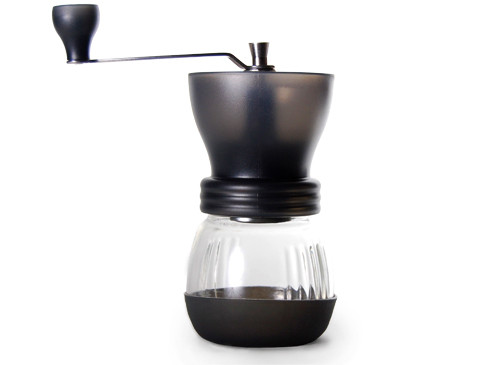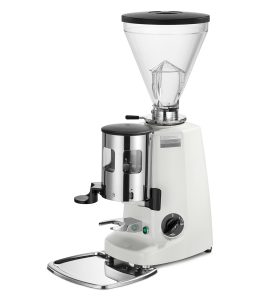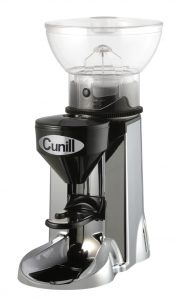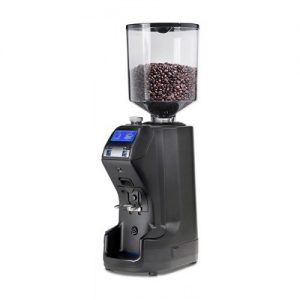All admirers of real black coffee probably know that the most delicious and aromatic drink is obtained from their freshly ground beans. Professional coffee grinder - a great solution for those who make coffee often and in large quantities. Such a device is designed for increased loads and long-term operation. Any coffee shop, bar or restaurant also uses professional coffee grinders. Find out what types of coffee grinders are and how to choose a high-quality model.

Content
Types of coffee grinders
All coffee grinders are divided into two main types:
- hand held;
- electric.
In order to better understand each device, as well as understand all the advantages and disadvantages of both types, we will consider them in more detail.
Manual coffee grinders
Coffee as a drink has been known for centuries. At a time when there was still no equipment, the grains were ground in a mortar. Roasted coffee is hard enough, so such work was not easy.
The first manual coffee grinder supposedly appeared in the 15th century in one of the eastern countries. The inventor of the device was an Arab.
Since then, to this day, the manual mill has not changed much. It is based on embossed metal disks (millstones) of a canonical shape, one of which is stationary, and the other rotates with the help of a handle attached from above. Through a funnel, grains are poured into the millstones, the mechanism is scrolled by hand, and the finished ground coffee is collected in a box located below. After the process is completed, the drawer is removed and the coffee is ready for use.
Previously, the millstones themselves and the body of a manual coffee grinder were made of metal. Later, such mills began to be made of wood, porcelain, and disks of metal or ceramics. Similar devices to this day have been preserved by someone at home, but they are found less and less on sale.
Manual coffee grinders have one important advantage: during the grinding process, millstones do not heat up, like electrical appliances. And as you know, when heated during grinding, grains lose some of their taste. The resulting coffee can be used to brew a drink in a Turk, a geyser coffee maker, and brewing in a French press.
Advantages of manual coffee grinders:
- Simple construction.
- Very compact size.
- Easy to care.
- It can be used in any situation and in places where there is no electricity.
- Silent work.
- Low cost.
- Very high wear resistance. Such devices can serve for decades.

Minuses:
- Scrolling millstones requires some effort.
- It takes about 5 minutes to grind a serving of coffee.
- Low productivity: only 1, maximum 2 servings of coffee can be poured into a coffee grinder at a time.
- To change the degree of grinding, it is necessary to disassemble the structure and tighten the adjusting nut that changes the distance between the millstones.
Manual coffee grinder is good as an additional device and decoration of the interior, but in the professional sphere is completely impractical.
Electric coffee grinders
Electric-powered coffee grinders come in several types (more on this below). Such mills completely eliminate manual labor and work very quickly. And if before electrical appliances were quite simple and had all one or two functions, today among such devices there are models with a large set of options.
The advantages of electric coffee grinders:
- Grinding grains in seconds.
- A large volume of coffee is placed in the container, you can grind the grains for several servings of the drink at a time.
- You can adjust the degree of grinding.
- Simple operation, easy maintenance.
Minuses:
- If the house turned off the light, do not make coffee.
- Noisy work.
- In the process of grinding coffee in some mills heats up, which negatively affects its taste.
- The motor may burn out, break down.
- Good, high-quality coffee grinders are not so cheap.

Types of Electric Coffee Grinders
It is obvious that the coffee grinder productive and professional must be electric. Using manual in a cafe or even at home in a large family is very impractical. Although many baristas on shelves in the bar can see the hand-held device, but only as a decoration.
So, we will consider what types of electric coffee grinders are divided into.
Knife (rotary)
Such a coffee grinder consists of a motor and a container, on the bottom of which knives are installed. When starting, the knives begin to rotate at high speed and grind coffee beans. Rotary coffee grinders are also sometimes called percussion. The degree of grinding directly depends on the device’s operating time: the longer the knives spin, the finer the coffee powder.
Their controls are push-button. There are models with just one start button, more expensive units have a speed controller, a timer. The ground powder remains in the same container where it was poured.
But professional coffee makers do not really like knife mills. They have two significant drawbacks:
- The grinding is heterogeneous.
- At high speeds, the knives heat up, which leads to the evaporation of ether in coffee.
Despite some disadvantages, rotary coffee grinders are in high demand. They are very practical in domestic use. Coffee, ground in a knife mill, is suitable for brewing a drink in a Turk, a drip coffee maker, a geyser, carob.
In the professional field, knife coffee grinders are practically not used.
Millstones
An electric millstone type device is completely identical to a manual coffee grinder, only it has a motor. The same conical millstones are used - one of the disks is static, and the other is movable. There are also models that have flat millstones, but they are less preferable, since they heat up during operation. The conical design remains cold during grain processing.
Although the rotation of the discs is much slower than the rotation of the knives in a rotary mill, the motor of a millstone is more powerful.
A big plus of such units is uniform grinding. Millstone electric coffee grinders have convenient grind controls via buttons or rotary toggle switches. Freshly roasted grains are poured into the upper container, and the finished powder is collected in another special compartment. In one cycle, you can process the volume of coffee at once into many cups.
Making coffee from a powder ground in a millstone can be done in coffee machines. From uniform grinding we get excellent aromatic espresso and americano.
The downside is the need for periodic change of disks that are erased with frequent use. Such models are used in the professional field.
Roller
Roller type grinders are on an industrial scale. They are used only in enterprises where they prepare ground coffee for sale. The principle of their operation is based on two rotating shafts. Through a special compartment in the middle of the shafts are fed grain. Getting into the shafts, they are frayed and powder is obtained at the exit. Roller units are only electric. The degree of grinding is adjusted by shifting the distance between the shafts. The denser the shafts are offset, the finer the grinding.
For use in everyday life and in the field of catering, such grinders are not used.
Additional features to consider when choosing
Those who are in the choice of a good professional coffee grinder should know all the nuances that you need to pay attention to when buying.
- Body material.Most electric coffee grinders are made of plastic, but professional models come in metal too. If you plan frequent operation of the unit, it is advisable to choose a metal case. When you liked the model made of plastic, you should make sure that it is very durable.
- Power. For a professional mill, power is important. The optimal parameter is considered to be power in the range of 150-200 watts. Larger models can have a power of 200-400 watts.
- Capacity. Obviously, the more coffee you can load into the appliance, the better and more convenient. Here you should focus on the volume of daily servings of the prepared drink.
- Portion dispenser. A very convenient feature that allows you to load a large amount of grains into a container, but grind them in specific portions.
- Serving Counter. This option will be useful in public catering establishments where strict accounting of consumed products and sales is kept.
- Grinding regulator. A professional coffee grinder is required to have such a regulator. Indeed, for different recipes of the drink, various grinding of coffee is necessary. On average, professional models have 5 to 15 degrees of grinding.
- Temper in the set. This is a special device for tamping coffee into the horn of a coffee maker. Temper always comes with a set of carob coffee machines, but it will not be superfluous in a set of coffee grinders.
- Timer. This option happens in rotary mills. You can set a specific time to get a particular degree of grinding.
- Overheat protection. When you have to grind a lot of coffee, protecting the motor from overheating is important and extends the life of the appliance.
- Protection against start without cover. In a high-quality unit, a protective system is necessarily integrated, which does not allow the activation of grinding if there is no lid on the container. The option is relevant for rotary appliances.
Doubtful "chips"
In stores and in advertising, you can see attractive information about advanced coffee grinders with antibacterial and double knives, unique bowls, megapower engines. But all these tempting "tricks" are very doubtful and are nothing more than marketing moves.
As practice shows, a double knife and the unusual shape of the container do not affect the grinding. And the antibacterial coating is completely perplexing: coffee is not stored in the coffee grinder, and the prepared powder is immediately sent to high-temperature processing.
Rating of professional coffee grinders
We present small reviews of the best professional-type coffee grinders with excellent characteristics and proven positive reviews from users.
Mazzer SUPER JOLLY manual

The 350 W millstone is geared towards high loads. The cup holds immediately 1.2 kg of grain coffee. In an hour, the device is capable of processing 7.5 kg of coffee. The container for the finished powder has a volume of 280 ml. The unit is equipped with a timer, portion dispenser, grinding degree regulators.
The case is made of metal, the type of millstone is flat, metal. For control buttons and rotary knobs are used. Estimated price - 35,000 rubles.
Cunill tranquilo

This model from the Spanish manufacturer is made in a very stylish design and is presented in several colors. The power of the device is 280 W, the capacity of the bean container is 500 g. In an hour, the machine processes up to 10 kg of coffee. Flat metal disks with a rotation speed of 1300-1600 rpm are also used here. The mill has a dispenser and adjustment of the grinding of grains. The container for ready-made coffee holds 500 g. The grinder is oriented to operation in bars, restaurants, coffee houses, but is also suitable for home use. The recommended price for the store is 15,000 p.
Cunill brasil

Another coffee machine from the Cunill brand, which differs from the above model only in a slightly larger volume and performance.Its loading container is designed for 1 kg of grains, and in an hour it processes 11 kg.
Millstones are flat, rotating at speeds up to 1600 rpm. The device has a grinding regulator, portion dispenser, motor protection against overheating. Like all the mills from this company, the Cunill Brasil coffee grinder combines elegant design and excellent features. You can buy a model for 15,200 p.
Nuova Simonelli MDX

Our rating is completed by a professional unit with a power of 290 watts. Flat millstones can grind up to 9 kg of coffee beans per hour. The container is designed for 1.2 kg of coffee. The maximum rotation speed of the conical discs is 900 rpm. The kit has a tamper, and the devas itself has options such as a portion dispenser, a grinding regulator. The metal case is presented in several colors. The average cost of a model is 29,000 p.
 |  |  |  |
|
| Title | Mazzer SUPER JOLLY manual | Cunill tranquilo | Cunill brasil | Nuova Simonelli MDX |
| Grinding system | millstone | millstone | millstone | millstone |
| Power | 350 watts | 280 watts | 280 watts | 290 watts |
| Capacity | 1200 g | 500 g | 1000 g | 1200 g |
| Grinding degree adjustment | there is | there is | there is | there is |
| Maximum rotation speed | 1600 rpm | 1300 rpm | - | 900 rpm |
| Price | from 45000 rub. | from 15300 rub. | from 18200 rub. | from 35000 rub. |